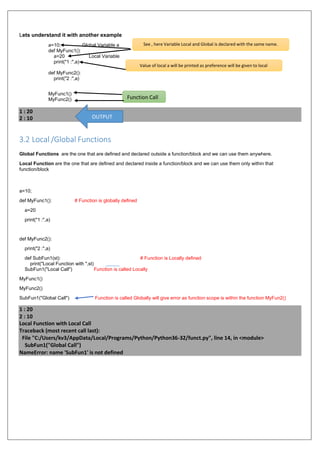The document discusses functions in the Python math module. It provides a list of common mathematical functions in the math module along with a brief description of what each function does, such as ceil(x) which returns the smallest integer greater than or equal to x, copysign(x, y) which returns x with the sign of y, and factorial(x) which returns the factorial of x. It also includes trigonometric functions like sin(x), cos(x), and tan(x), their inverse functions, and functions for exponentials, logarithms, and other common mathematical operations.

![Calling function MyMsg1
1.2 User-Defined Functions (UDFs):
Following are the rules to define a User Define Function in Python.
Function begin with the keyword def followed by the function name and parentheses ( ) .
Any list of parameter(s) or argument(s) should be placed within these parentheses.
The first statement within a function is the documentation string of the function
or docstring is an optional statement
The function block within every function starts with a colon (:) and is indented.
The statement return [expression] exits a function, optionally passing back an expression
to the caller. A return statement with no arguments is the same as return None.
Syntax
By default, parameters have a positional behavior and you need to inform them in the
same order that they were defined.
Example for Creating a Function without parameter
In Python a function is defined using the def keyword:
>>> def MyMsg1():
print("Learning to create function")
Example for Creating a Function parameter
The following function takes a string as parameter and prints it on screen.
Calling a Function To call a function, use the function name followed by
parenthesis:
>>> MyMsg1()
def functionName( list of parameters ):
"_docstring"
function_block
return [expression]
docString
return
def MyMsg2( name ):
"This prints a passed string into this function"
print (name ,’ is learning to define Python Function’)
Learning to create function
Output
>>> MyMsg2(‘Divyaditya’)
>>> MyMsg2(‘Manasvi’)
Calling Function MyMsg2() twice with different parameter
Manasvi is learning to define Python Function
Output
Divyaditya is learning to define Python Function](https://image.slidesharecdn.com/functions-best-220522143934-b63497bd/85/functions-best-pdf-2-320.jpg)
![2. Parameter (argument) Passing
We can define UDFs in one of the following ways in Python
1. Function with no argument and no Return value [ like MyMsg1(),Add() ]
2. Function with no argument and with Return value
3. Python Function with argument and No Return value [like MyMsg2() ]
4. Function with argument and Return value
# Python Function with Arguments, and No Return Value FUNCTION 2
def Add2(a,b):
Sum = a + b
print("Result:", Sum)
Add2(20,30)
Here we are passing 2 parameters a,b to the function and
function is calculating sum of these parameter and result is
printed within the function . It is not returning any value
3. Scope : Scope of a Variable or Function may be Global or
Local
3.1 Global and Local Variables in Python
Global variables are the one that are defined and declared outside a function and we can use them anywhere.
Local variables are the one that are defined and declared inside a function/block and we can use them only within that function or
block
A=50
def MyFunc():
print("Function Called :",a)
# Python Function with Arguments, and Return Value FUNCTION 3
def Add3(a,b):
Sum = a + b
Return Sum
Here we are passing 2 parameters a,b to the function and function is
calculating sum of these parameter and result is returned to the calling
Z=Add3(10,12) statement which is stored in the variable Z
print(“Result “ Z)
# Python Function with No Arguments, and Return Value FUNCTION 4
def Add4():
a=11
b=20
Sum = a + b
Return Sum
Here we are not passing any parameter to function instead values
are assigned within the function but result is returned.
Z=Add3(10,12)
print(“Result “ Z)
Global Varialble
# Python Function with No Arguments, and No Return Value FUNCTION 1
def Add1():
a = 20
b = 30
Sum = a + b
Here we are not passing any parameter to function instead values are assigned within
the function and result is also printed within the function . It is not returning any value
print("After Calling the Function:", Sum)
Add1()
MyFunc()
Function Called : 50 OUTPUT](https://image.slidesharecdn.com/functions-best-220522143934-b63497bd/85/functions-best-pdf-3-320.jpg)



![This example illustrates that, in Python, a function cannot produce the side effect of changing the value of
an integerobject (nothing can do so). To increment variable i, we could use the definition
and call the function with the assignment statement i = inc(i).
The same holds true for any immutable type. A function cannot change the value of an integer, a float, a boolean,
or a string.
Arrays as arguments
When a function takes an array as an argument, it implements a function that operates on an arbitrary
number of objects.For example, the following function computes the mean (average) of an array of floats
or integers:
We have been using arrays as arguments from the beginning of the book. For example, by convention, Python
collects the
strings that you type after the program name in the python command into an arraysys.argv[] and implicitly
calls your globalcode with that array of strings as the argument.
Side effects with arrays
Since arrays are mutable, it is often the case that the purpose of a function that takes an array as argument is
to produce aside effect (such as changing the order of array elements). A prototypical example of such a
function is one that exchangesthe elements at two given indices in a given array. We can adapt the code that
we examined at the beginning of SECTION 1.4:
This implementation stems naturally from the Python array representation. The first parameter variable in
exchange() is a reference to the array, not to all of the array’s elements: when you pass an array as an argument
to a function, you are giving it the opportunity to operate on that array (not a copy of it). A formal trace of a call
on this function is shown on thefacing page. This diagram is worthy of careful study to check your understanding
of Python’s function-call mechanism.
A second prototypical example of a function that takes an array argument and produces side effects is one
that randomlyshuffles the elements in the array,
def inc(j):
j += 1
return j
def mean(a):
total = 0.0
for v in a:
total += v
return total / len(a)
def exchange(a, i, j):
temp = a[i]
a[i] = a[j]
a[j] = temp](https://image.slidesharecdn.com/functions-best-220522143934-b63497bd/85/functions-best-pdf-7-320.jpg)

![Arrays as return values
A function that sorts, shuffles, or otherwise modifies an array taken as argument does not have to return a
reference to thatarray, because it is changing the contents of a client array, not a copy. But there are many
situations where it is useful for afunction to provide an array as a return value. Chief among these are
functions that create arrays for the purpose of returning multiple objects of the same type to a client.
As an example, consider the following function, which returns an array of random floats:
functions.
mean of an array
def mean(a):
total = 0.0
for v in a:
total += v
dot product of two vectors of the same length
def dot(a, b):
total = 0
for i in range(len(a)):
total += a[i] * b[i]
exchange two elements in an array
def exchange(a, i, j):
temp = a[i]
a[i] = a[j]
a[j] = temp
write a one-dimensional array (and its length)
def write1D(a):
stdio.writeln(len(a))
for v in a:
stdio.writeln(v)
read a two-dimensional array of floats (with dimensions)
def readFloat2D():
m = stdio.readInt()
n = stdio.readInt()
a = stdarray.create2D(m, n, 0.0)
def randomarray(n):
a = stdarray.create1D(n)
for i in range(n):
a[i] = random.random()
return a](https://image.slidesharecdn.com/functions-best-220522143934-b63497bd/85/functions-best-pdf-9-320.jpg)
![6. FUNCTION USING LIBRARIEs:
6.1 Functions in Python Math Module
Here is the list of all the functions and attributes defined in math module with a brief explanation of
what they do.
List of Functions in Python Math Module
Function Description
ceil(x) Returns the smallest integer greater than or equal to x.
copysign(x, y) Returns x with the sign of y
fabs(x) Returns the absolute value of x
factorial(x) Returns the factorial of x
floor(x) Returns the largest integer less than or equal to x
fmod(x, y) Returns the remainder when x is divided by y
frexp(x) Returns the mantissa and exponent of x as the pair (m, e)
fsum(iterable) Returns an accurate floating point sum of values in the iterable
isfinite(x) Returns True if x is neither an infinity nor a NaN (Not a Number)
isinf(x) Returns True if x is a positive or negative infinity
isnan(x) Returns True if x is a NaN
ldexp(x, i) Returns x * (2**i)
modf(x) Returns the fractional and integer parts of x
trunc(x) Returns the truncated integer value of x
exp(x) Returns e**x
expm1(x) Returns e**x - 1
log(x[, base]) Returns the logarithm of x to the base (defaults to e)
log1p(x) Returns the natural logarithm of 1+x
log2(x) Returns the base-2 logarithm of x
log10(x) Returns the base-10 logarithm of x
pow(x, y) Returns x raised to the power y
sqrt(x) Returns the square root of x
acos(x) Returns the arc cosine of x
asin(x) Returns the arc sine of x
atan(x) Returns the arc tangent of x
atan2(y, x) Returns atan(y / x)
cos(x) Returns the cosine of x
hypot(x, y) Returns the Euclidean norm, sqrt(x*x + y*y)
sin(x) Returns the sine of x
tan(x) Returns the tangent of x
degrees(x) Converts angle x from radians to degrees
radians(x) Converts angle x from degrees to radians
acosh(x) Returns the inverse hyperbolic cosine of x
asinh(x) Returns the inverse hyperbolic sine of x
atanh(x) Returns the inverse hyperbolic tangent of x
cosh(x) Returns the hyperbolic cosine of x
sinh(x) Returns the hyperbolic cosine of x
tanh(x) Returns the hyperbolic tangent of x
erf(x) Returns the error function at x
erfc(x) Returns the complementary error function at x
gamma(x) Returns the Gamma function at x
lgamma(x) Returns the natural logarithm of the absolute value of the Gamma
function at x
pi Mathematical constant, the ratio of circumference of a circle to it's
diameter (3.14159...)
e mathematical constant e (2.71828...)](https://image.slidesharecdn.com/functions-best-220522143934-b63497bd/85/functions-best-pdf-10-320.jpg)
